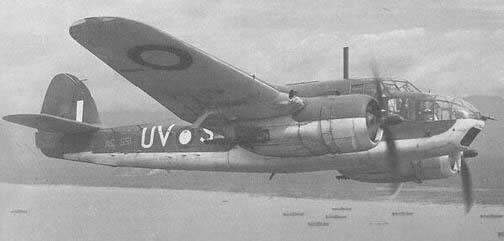 |
|
|||
|
|
||||
 |
|
Developed from the Blenheim light bomber, the Beaufort proved to be heavier than it's parent design. This extra weight, in part because of the additional crewman, proved to be too much for the original Bristol Mercury engines. After reviewing several designs, the Bristol Taurus was chosen though there were initial installation problems. These installation problems, among them a tendency to overheat, delayed development somewhat. However, two squadrons were operational by August 1940, the 22 and 42 Squadrons of Coastal Command. The Beaufort served the Coastal Command well, laying hundreds of mines and were involved in the attacks on the Scharnhorst and the Gneisenau as well as numerous attacks on smaller shipping. Plans for producing the type in Australia were begun in 1939. The logistical problems of supplying engines from England led to the Pratt & Whitney Twin Wasp being adapted to the design. One hundred sixty five of British built Beaufort Mk. IIs were equipped with this engine as well but then reverted to the Taurus from 166 on. Australian versions can be identified by a larger tail fin and several different derivatives were developed including trainer and transport versions. |
| Type:
Four-Seat Torpedo Bomber Origin: Bristol Models: Mark I to VIII First Flight: October 15, 1938 Service Delivery: October 1939 First Flight (Australia, Mark V): August 1941 Final Delivery (Australia): August 1944 Number Produced: 2,080 (700 Australian built) Engine: Mark I, II (from number 166 on), III, IV Model: Bristol Taurus VI Type: 14 Cylinder Sleeve-valve radial Number: Two Horsepower: 1,130 hp Mark II (First 165), V through VIII Model: Bristol Taurus VI Type: 14 Cylinder Sleeve-valve radial Number: Two Horsepower: 1,130 hp Dimensions: Wing span: 57 ft. 10 in. (17.63m) Length: 44 ft. 2 in. (13.46m) Height: 14 ft. 3 in. (4.34m) Wing Surface Area: N/A Weights: Empty: 13,107 lbs. (5945 kg) Max. Take-Off: 21,230 lbs. (9629 kg) |
Performance: Maximum Speed: Clean: 260 mph (418 km/h) With Torpedo: 225 mph (362 km/h) Initial climb: N/A Service Ceiling: 16,500 ft. (5030m) Range: 1,600 Miles (2575 km) Armament: Typical: Two .303 in. Vickers K in dorsal turret. One .303 in. Vickers K in left wing. Alternate: Four .303 in. Brownings in wing. Two .303 in. Brownings manually aimed from beam windows. Mk. II and final 140 Australian Mk. VIII: Four .303 in. Brownings in wing. Two .303 in. Brownings manually aimed from beam windows. Two .303 in. Brownings in dorsal turret. Payload: One 18 in. torpedo mounted semi-externally to left of centreline or bomb load of 2,000 lb. (907 kg.) |
